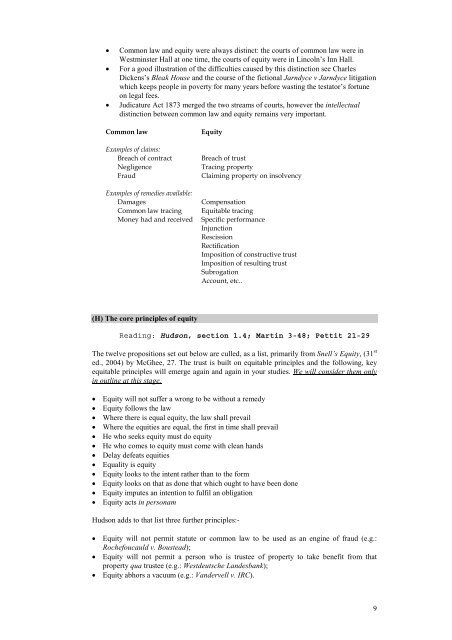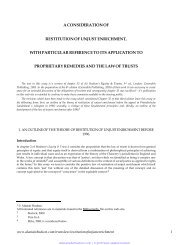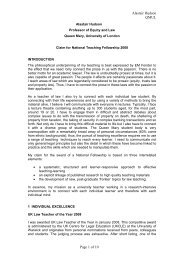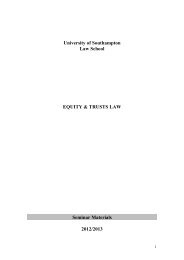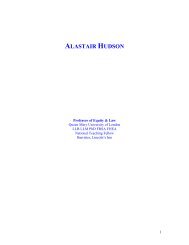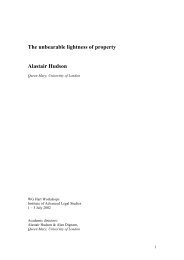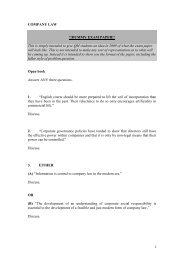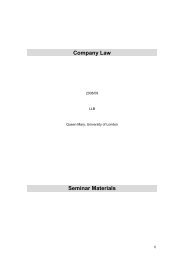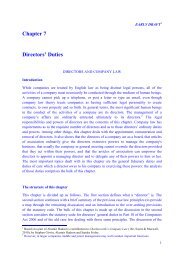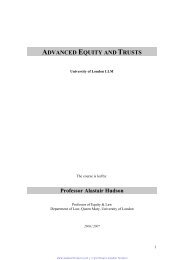Soton Equity and Trusts - alastairhudson.com
Soton Equity and Trusts - alastairhudson.com
Soton Equity and Trusts - alastairhudson.com
You also want an ePaper? Increase the reach of your titles
YUMPU automatically turns print PDFs into web optimized ePapers that Google loves.
Common law <strong>and</strong> equity were always distinct: the courts of <strong>com</strong>mon law were in<br />
Westminster Hall at one time, the courts of equity were in Lincoln’s Inn Hall.<br />
For a good illustration of the difficulties caused by this distinction see Charles<br />
Dickens’s Bleak House <strong>and</strong> the course of the fictional Jarndyce v Jarndyce litigation<br />
which keeps people in poverty for many years before wasting the testator’s fortune<br />
on legal fees.<br />
Judicature Act 1873 merged the two streams of courts, however the intellectual<br />
distinction between <strong>com</strong>mon law <strong>and</strong> equity remains very important.<br />
Common law<br />
Examples of claims:<br />
Breach of contract<br />
Negligence<br />
Fraud<br />
Examples of remedies available:<br />
Damages<br />
Common law tracing<br />
Money had <strong>and</strong> received<br />
<strong>Equity</strong><br />
Breach of trust<br />
Tracing property<br />
Claiming property on insolvency<br />
Compensation<br />
Equitable tracing<br />
Specific performance<br />
Injunction<br />
Rescission<br />
Rectification<br />
Imposition of constructive trust<br />
Imposition of resulting trust<br />
Subrogation<br />
Account, etc..<br />
(H) The core principles of equity<br />
Reading: Hudson, section 1.4; Martin 3-48; Pettit 21-29<br />
The twelve propositions set out below are culled, as a list, primarily from Snell’s <strong>Equity</strong>, (31 st<br />
ed., 2004) by McGhee, 27. The trust is built on equitable principles <strong>and</strong> the following, key<br />
equitable principles will emerge again <strong>and</strong> again in your studies. We will consider them only<br />
in outline at this stage.<br />
<br />
<br />
<br />
<br />
<br />
<br />
<br />
<br />
<br />
<br />
<br />
<br />
<strong>Equity</strong> will not suffer a wrong to be without a remedy<br />
<strong>Equity</strong> follows the law<br />
Where there is equal equity, the law shall prevail<br />
Where the equities are equal, the first in time shall prevail<br />
He who seeks equity must do equity<br />
He who <strong>com</strong>es to equity must <strong>com</strong>e with clean h<strong>and</strong>s<br />
Delay defeats equities<br />
Equality is equity<br />
<strong>Equity</strong> looks to the intent rather than to the form<br />
<strong>Equity</strong> looks on that as done that which ought to have been done<br />
<strong>Equity</strong> imputes an intention to fulfil an obligation<br />
<strong>Equity</strong> acts in personam<br />
Hudson adds to that list three further principles:-<br />
<br />
<br />
<br />
<strong>Equity</strong> will not permit statute or <strong>com</strong>mon law to be used as an engine of fraud (e.g.:<br />
Rochefoucauld v. Boustead);<br />
<strong>Equity</strong> will not permit a person who is trustee of property to take benefit from that<br />
property qua trustee (e.g.: Westdeutsche L<strong>and</strong>esbank);<br />
<strong>Equity</strong> abhors a vacuum (e.g.: V<strong>and</strong>ervell v. IRC).<br />
9


